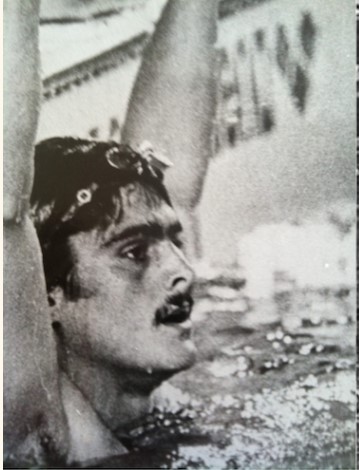Jonty Skinner
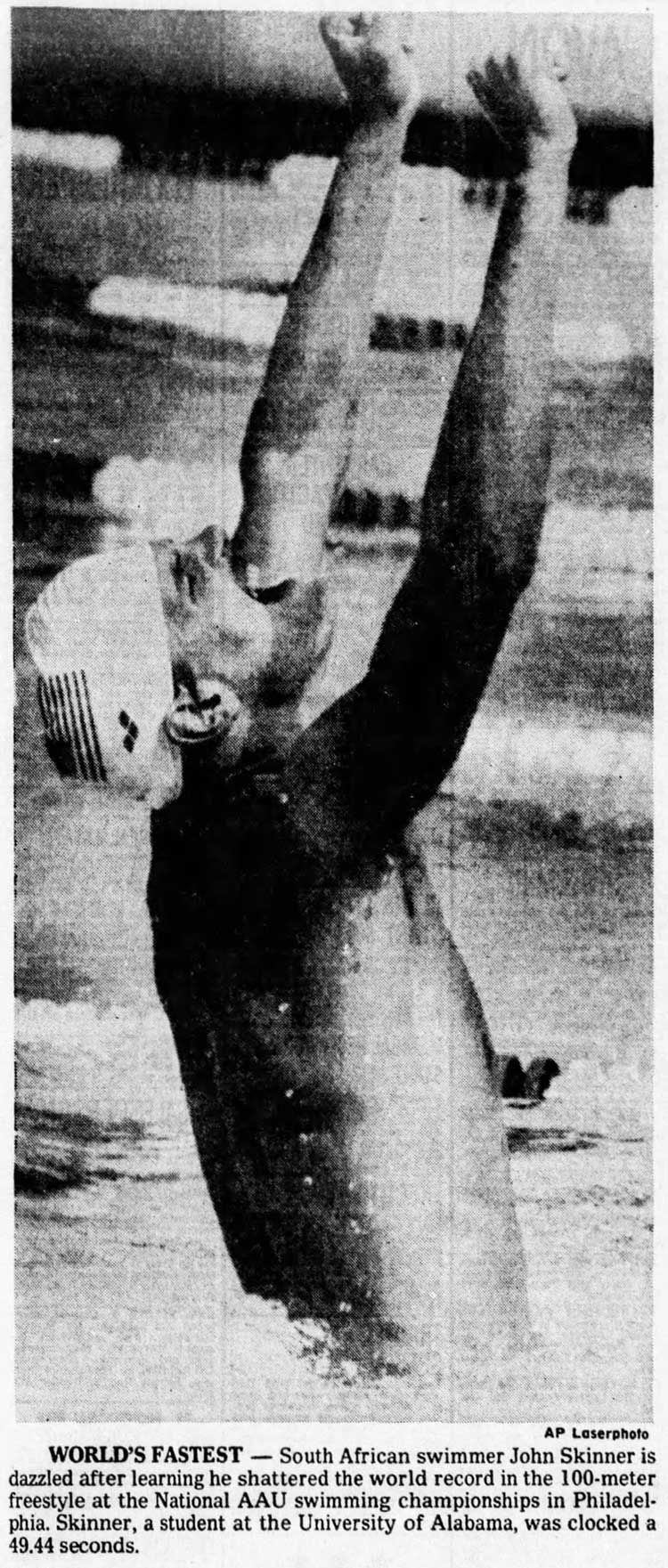
John Alexander Skinner was born in Mowbray, Cape Town on 15th February 1954 and matriculated from Selborne College in East London. His father was the well-known local swimming coach Doug Skinner.
His early swimming efforts were concentrated on surf lifesaving, where he was soon to become a dominant figure. After winning his Springbok colours on the 1971 tour to Australia and New Zealand, he made an almost complete clean sweep of titles at the 1972 SA Surf Lifesaving Championships.
That year also showed the first sign of things to come when he finished second in the 100m freestyle at the 1972 Port Elizabeth nationals. On a Springbok swimming tour to Germany, he beat a world-class field in a time of 52,99, which placed him 5th in the world rankings.
At the 1973 SA nationals in Bulawayo, he won the 100-metre freestyle event and backed that up by winning the event again at the 1974 National Championships. He was awarded the title of South Africa Athlete of the Year and was also awarded Springbok Colours in Swimming and Life Saving.
Accepting a scholarship to swim at the University of Alabama, Jonty left for the USA after winning the 100m freestyle at the 1974 Bloemfontein nationals. At the 1975 Division I NCAA Men's Swimming and Diving Championships, he won the 100 yards freestyle in an American record time of 43,92 (the record is 43,15 in 2014) and was voted Alabama's most valuable swimmer in 1975, 1976, and 1977. He was also voted as Alabama's Athlete of the Year.
During the university summer breaks, Jonty swam with coach Bill Palmer at the Central Jersey Aquatic Club in Asbury Park, which club he was representing at the AAU nationals in 1976.
In 1976, he weighed 185 pounds, stood 6'5", and had a good chance of taking the gold medal in the 100-meter freestyle at the 1976 Summer Olympics in Montreal. Unfortunately, South Africans were banned from the Olympics - hence making Skinner ineligible to compete.
However, after the completion of the Olympics, at the 1976 United States, Summer National Swimming Championships in Philadelphia, Pennsylvania, and after just qualifying for the final, Skinner broke Jim Montgomery's 20-day-old world record in the 100-meter freestyle by 0.55 seconds beating home the Olympic champion and Joe Bottom who won silver in Montreal. His record stood until 3 April 1981 when Rowdy Gaines swam the distance in 49.36 seconds in Texas. In addition to his world record, he set three American records in the 100-yard freestyle.
In 1985, he was recognized by the swimming world when he was inducted into the International Swimming Hall of Fame as an Honour Swimmer.
After his swimming career ended, Jonty followed in his father's footsteps and became a swim coach and consultant to various countries - including being a US Olympic coach.
From 1981-1988, Skinner served as head coach at the San Jose Aquatic Club, where he won five junior national championship team titles and one national championship team title.
From 1994-2000 Skinner served as USA Swimming’s Resident Team Coach, which involved coaching some of the nation’s top swimmers at the elite national and international level.
Before he arrived at USA Swimming, Skinner served as head coach of the men’s and women’s swimming teams at the University of Alabama. Under Skinner’s guidance, both the men’s and women’s swimming programs finished in the top 10 nationally in 1994. That same year Skinner won the Southeastern Conference (SEC) Women’s Coach of the Year award.
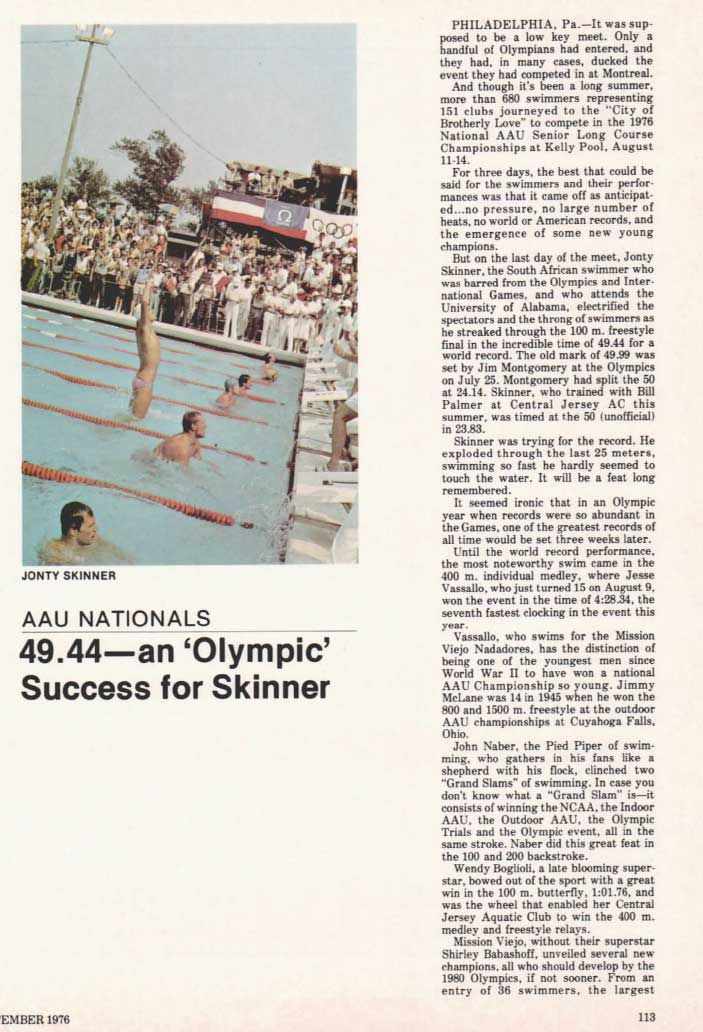
1976 Skinner Article Swimming World 1
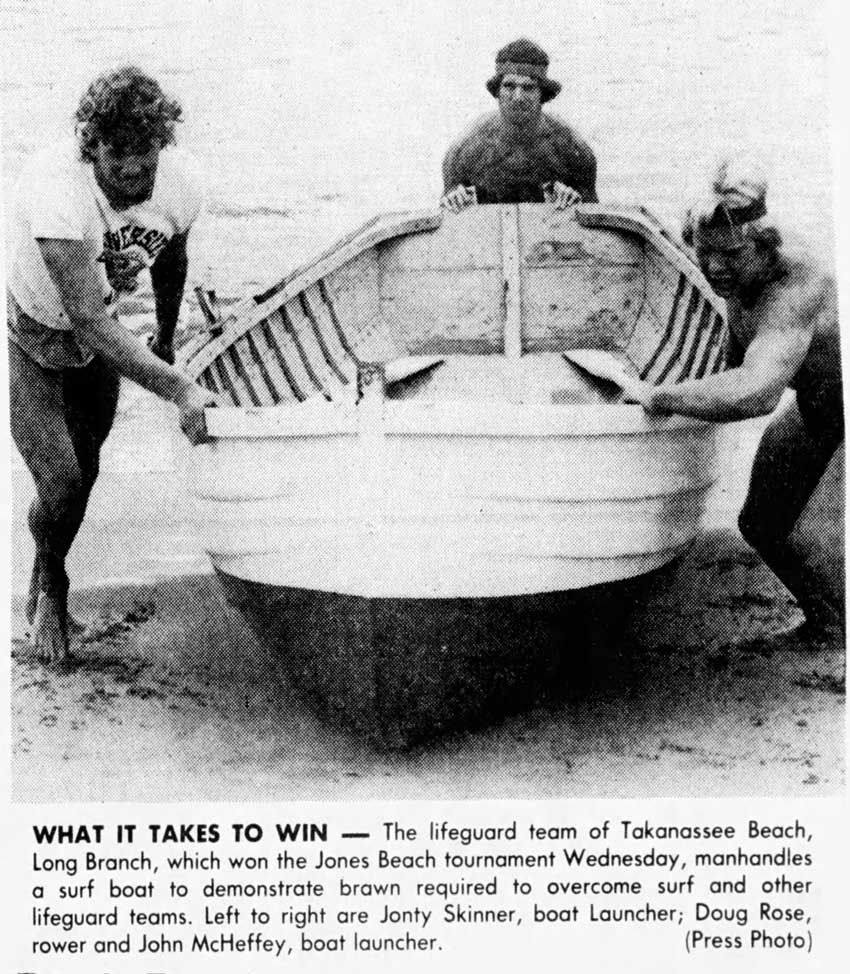
Asbury Park Press Sat Aug 9 1975
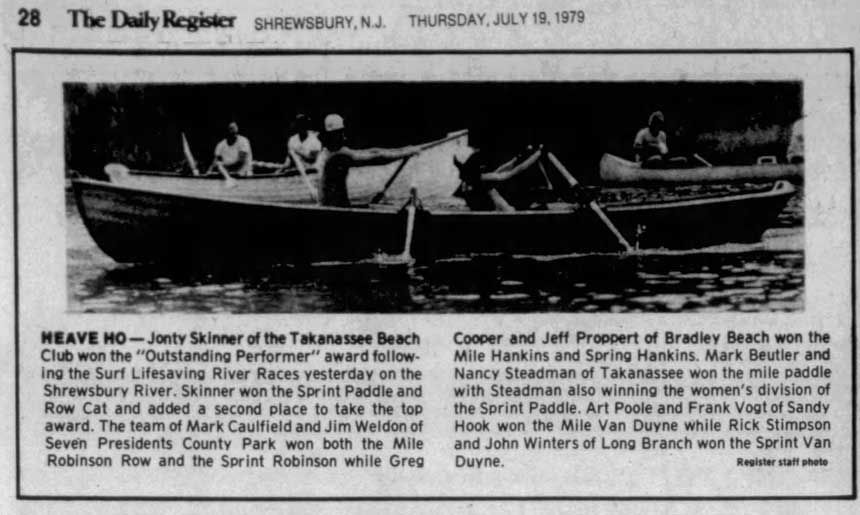
The Daily Register Thu Jul 19 1979
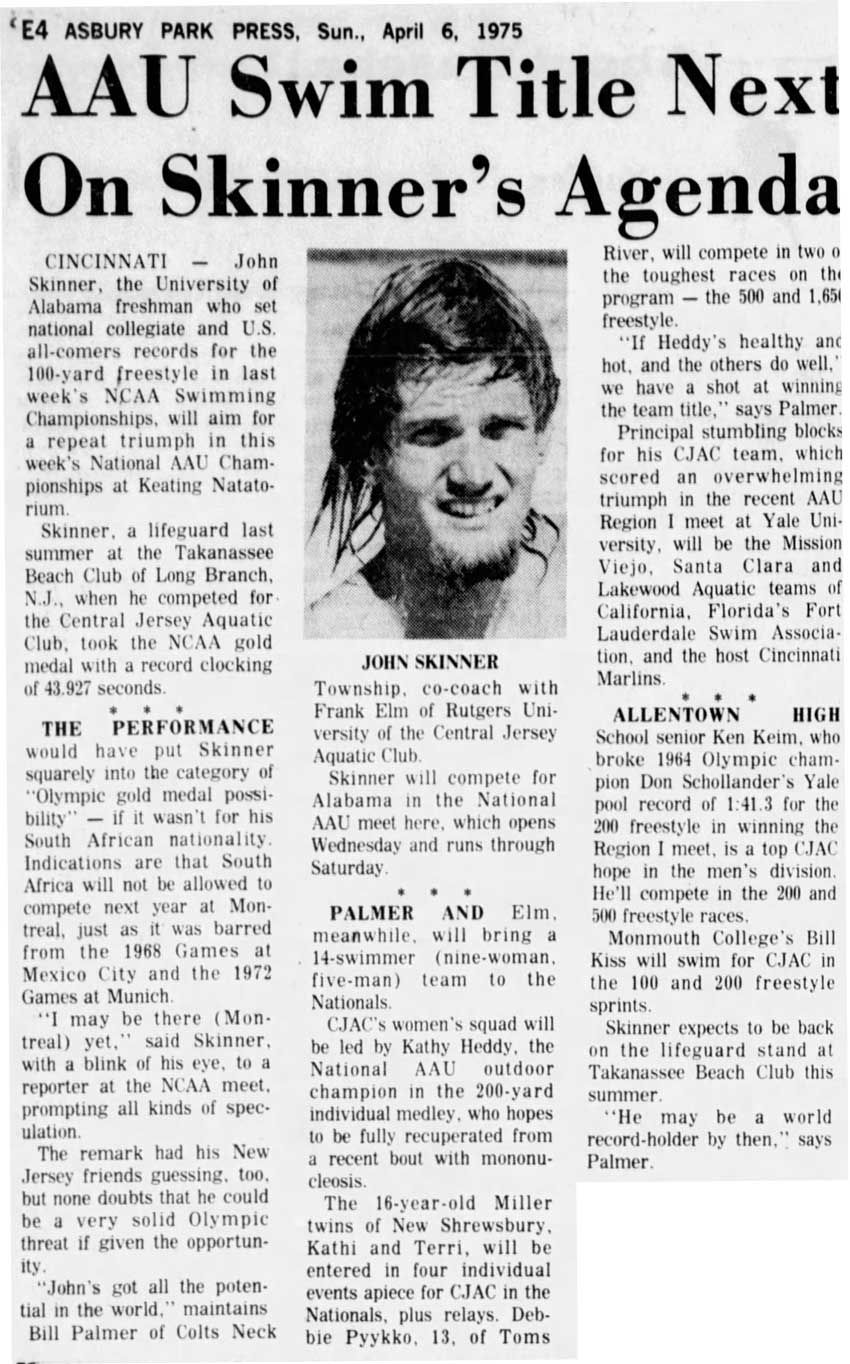
Asbury Park Press Sun Apr 6 1975
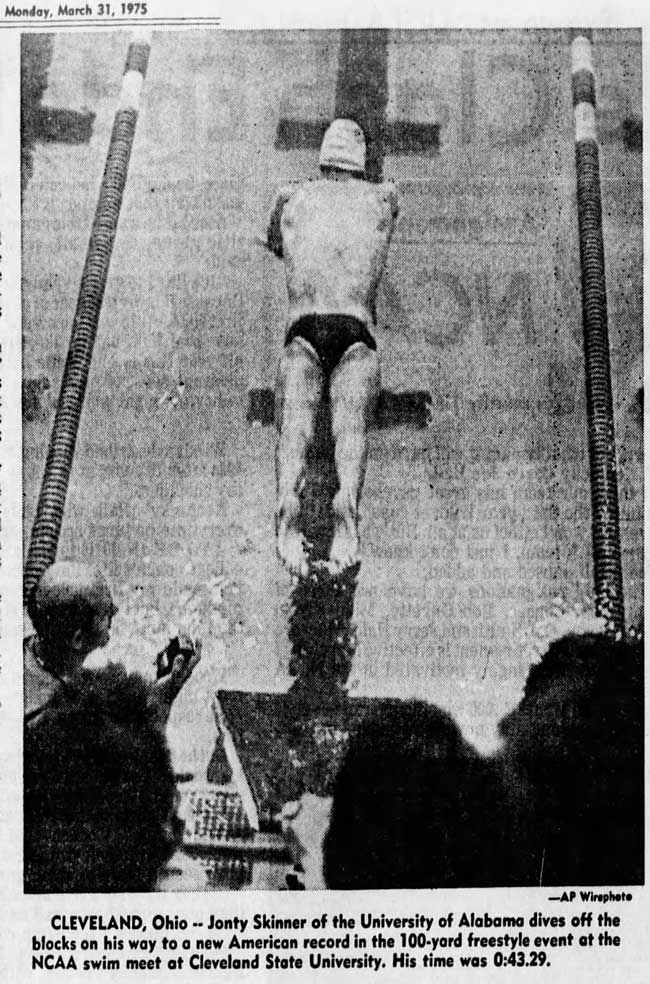
Jonty Mar 31 1975
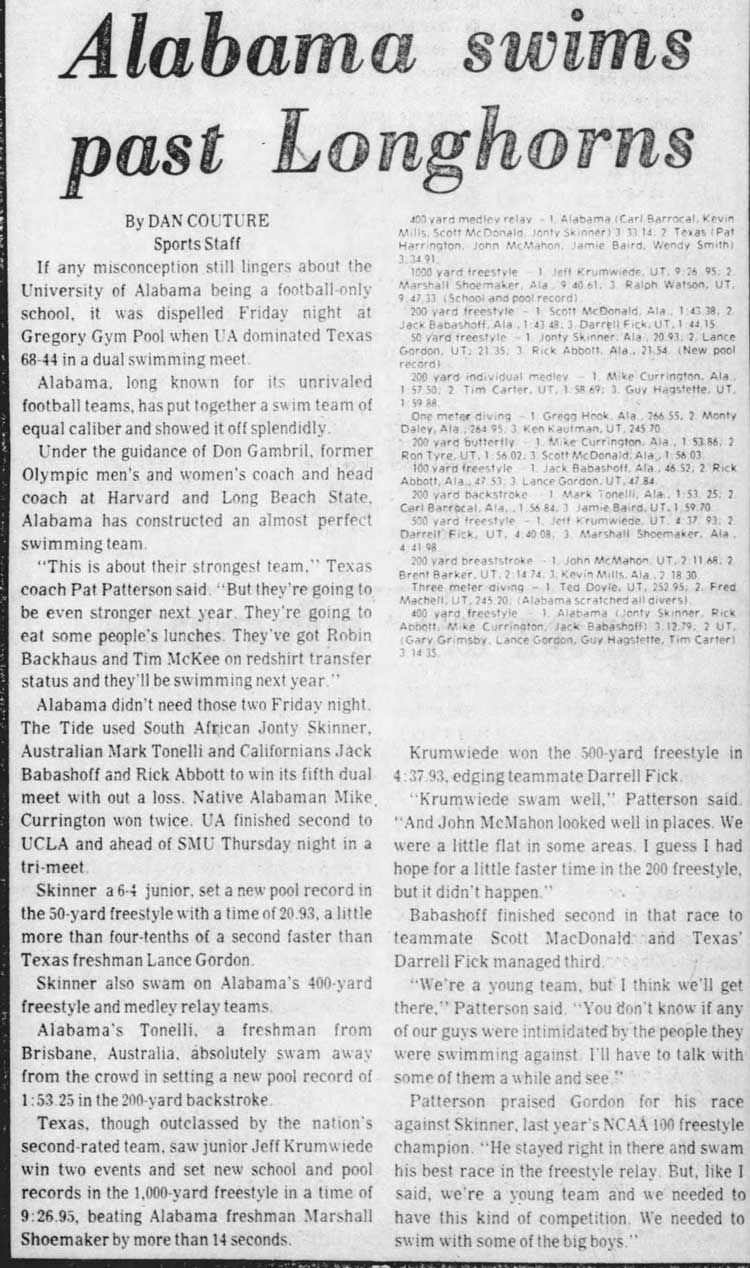
Austin American Statesman Sat Jan 24 1976
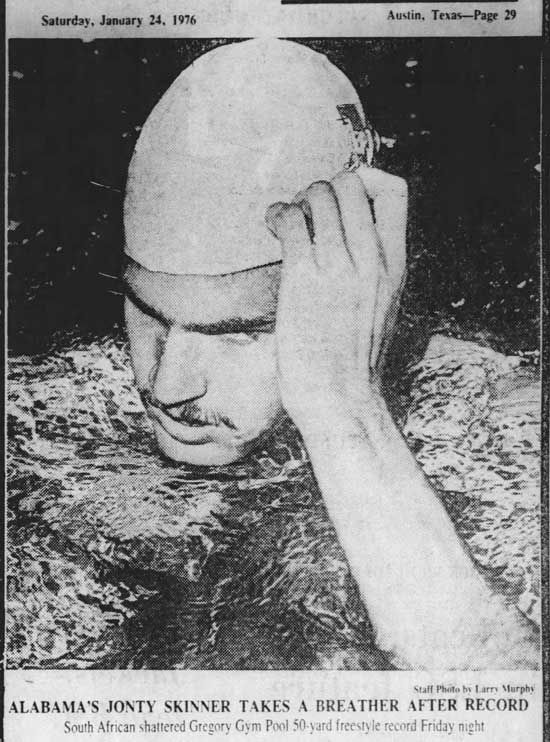
Austin American Statesman Sat Jan 24 1976 1

Jonty 1

Jonty Aug 15 1976 1
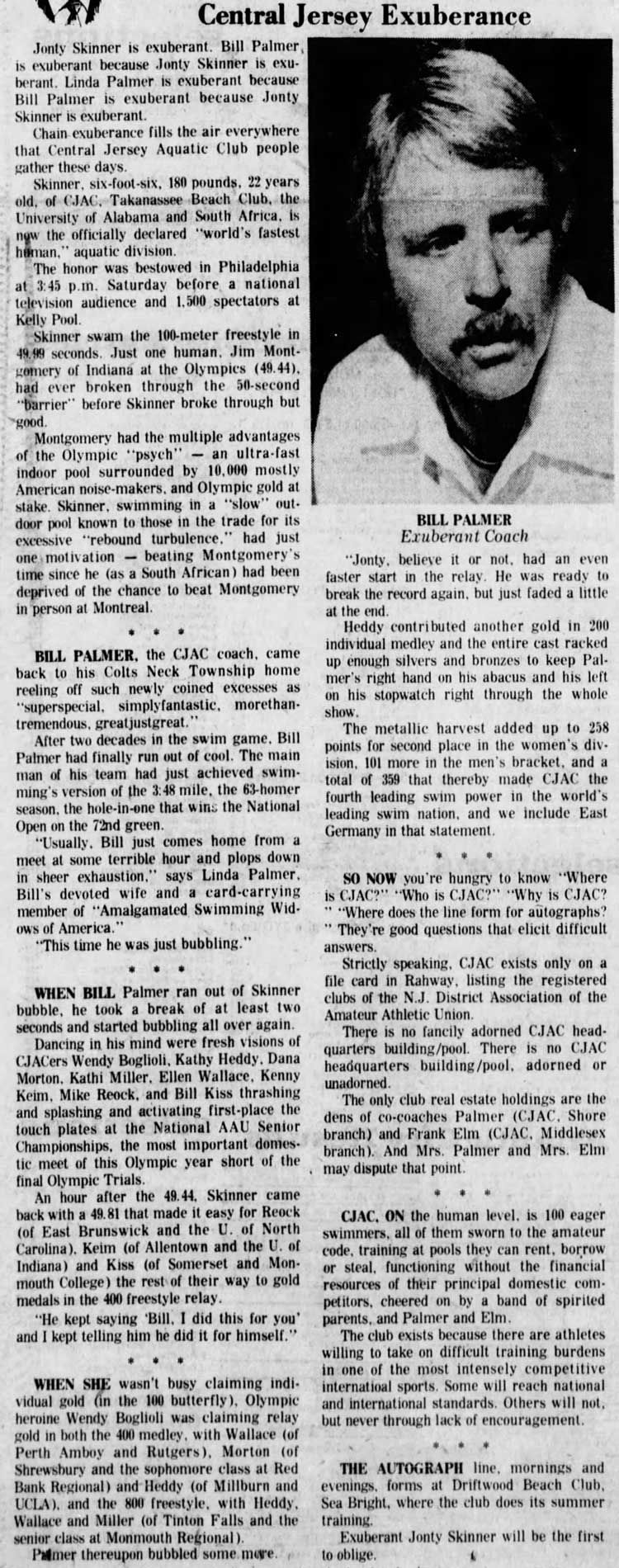
Jonty Aug 16 1976 1
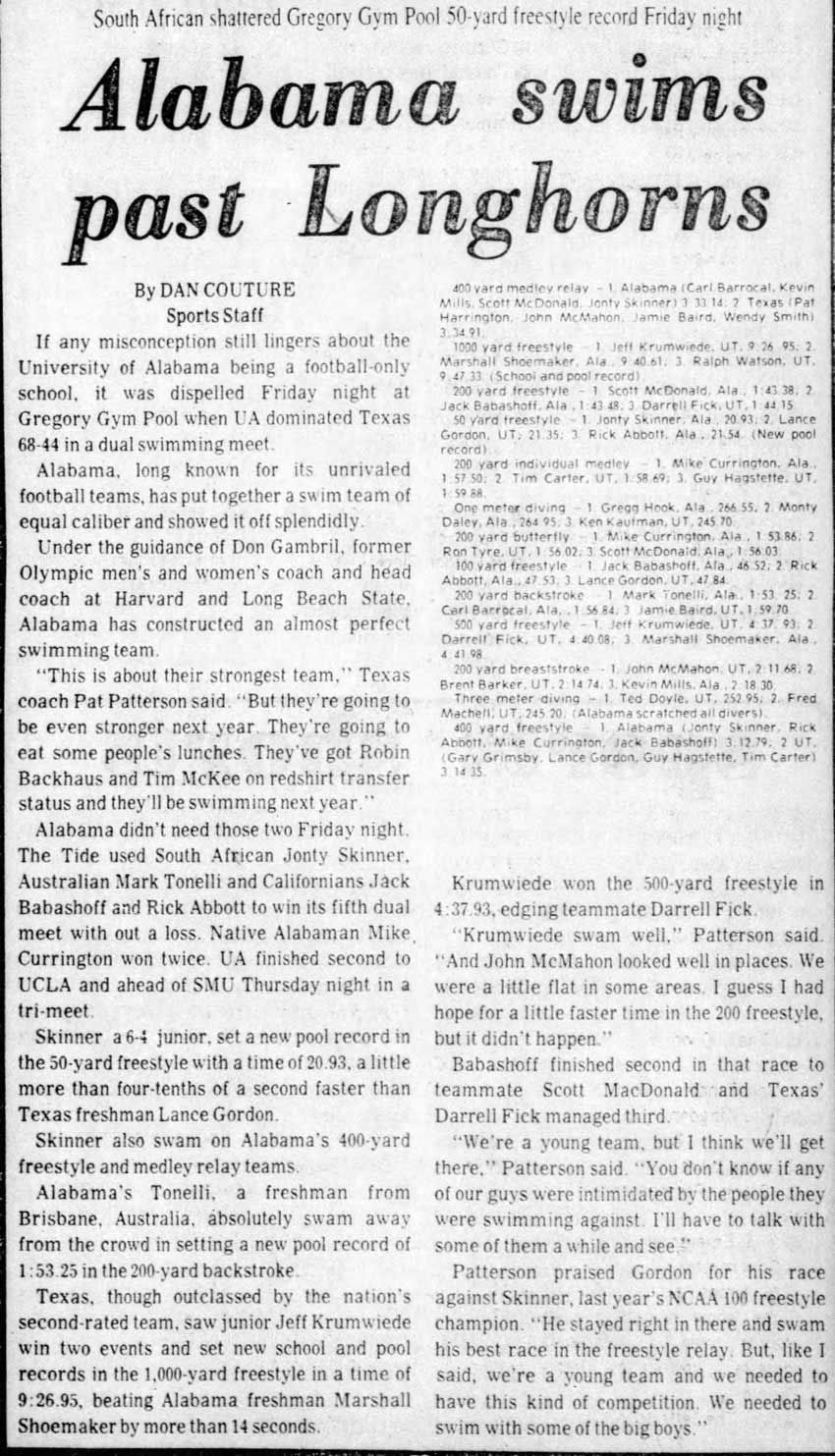
Jonty Jan 24 1976
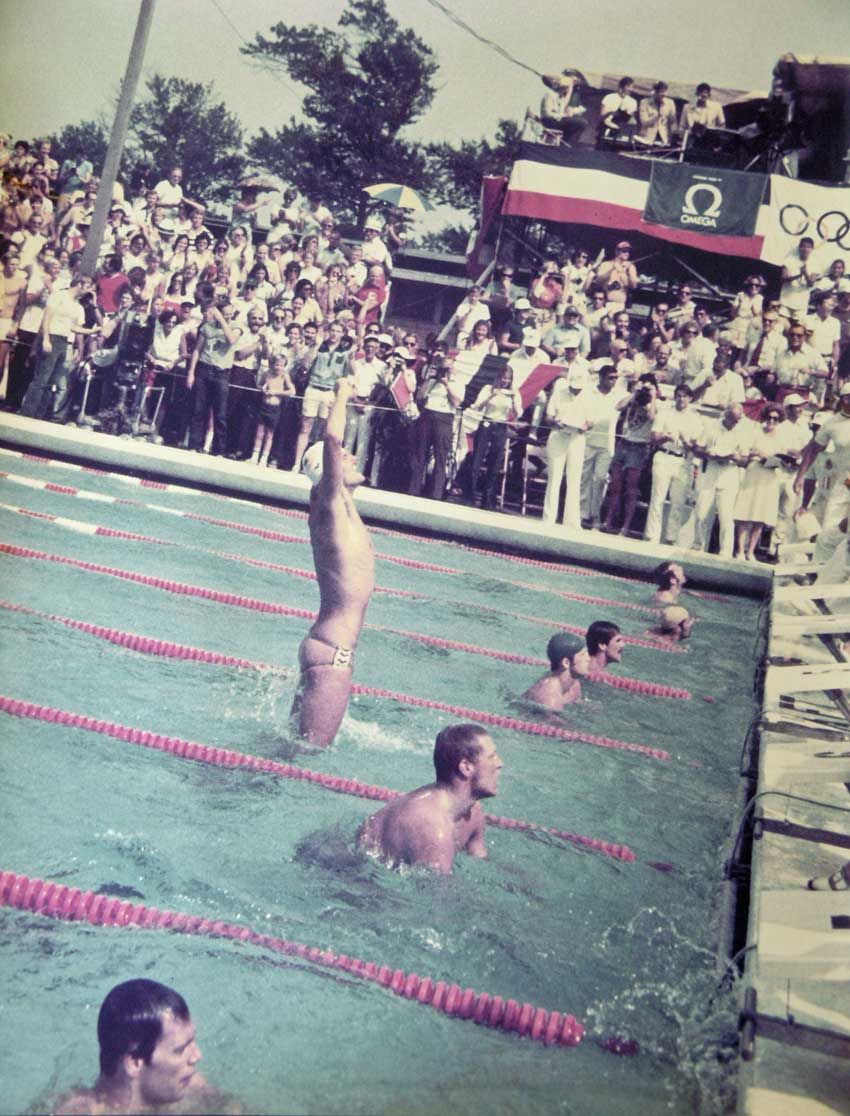
Jonty WR 7608 1
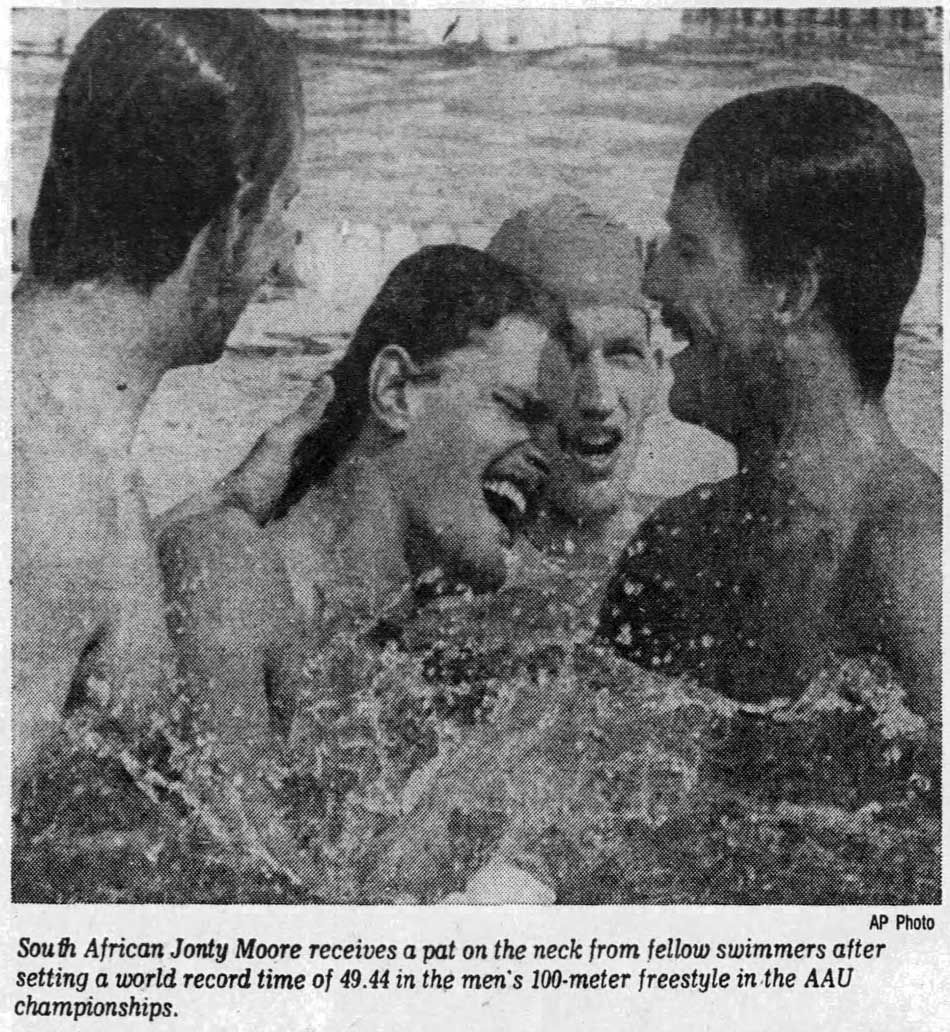
The Record Sun Aug 15 1976

Statesman Journal Sun Mar 28 1976
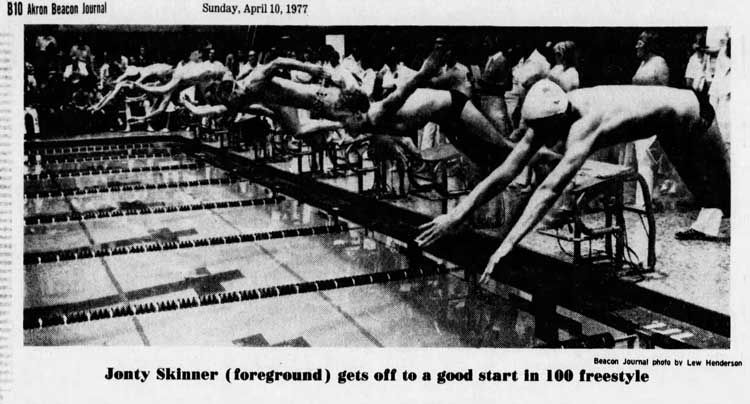
The Akron Beacon Journal Sun Apr 10 1977 1
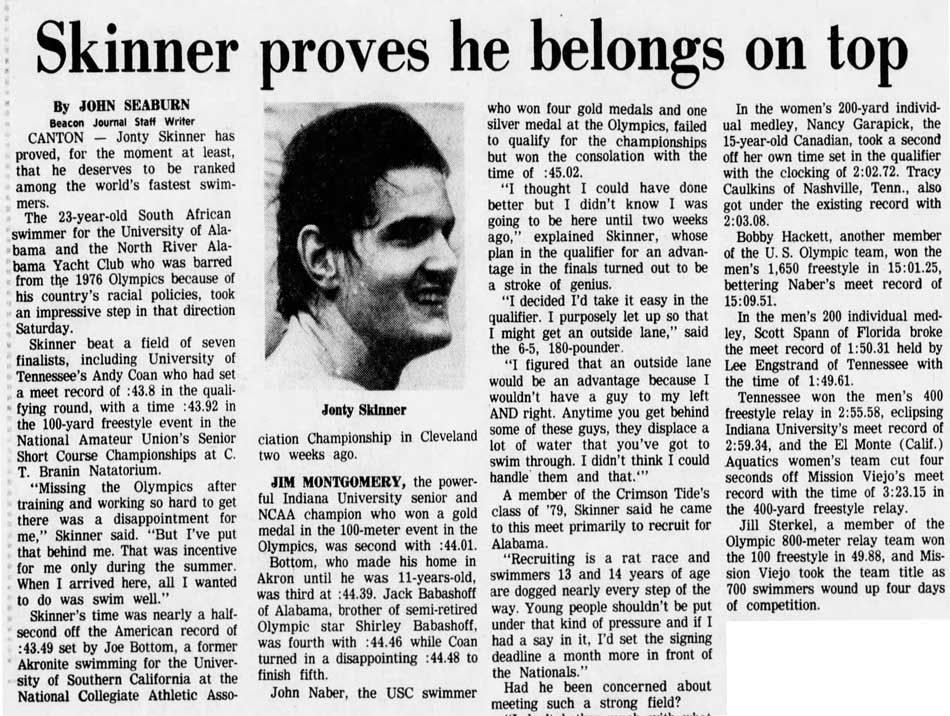
The Akron Beacon Journal Sun Apr 10 1977
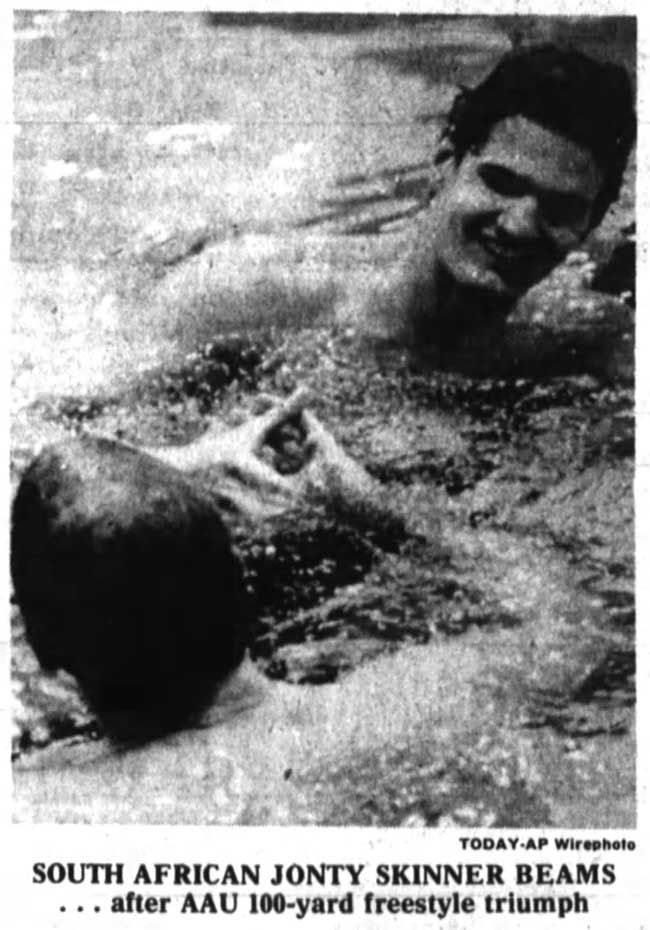
Florida Today Sun Apr 10 1977
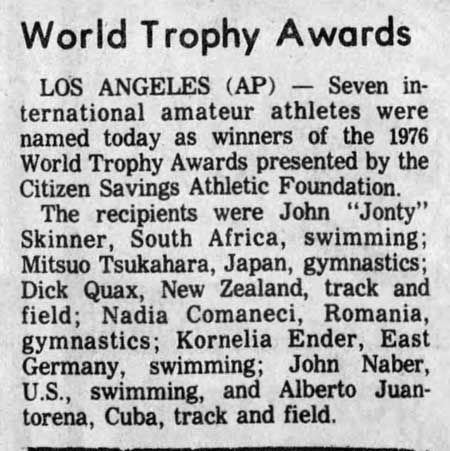
The Clarksdale Press Register Thu Jan 20 1977
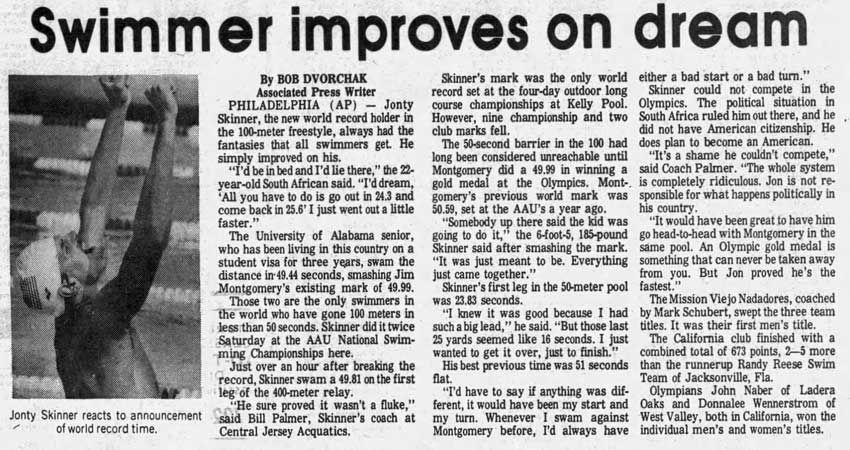
The Courier News Mon Aug 16 1976
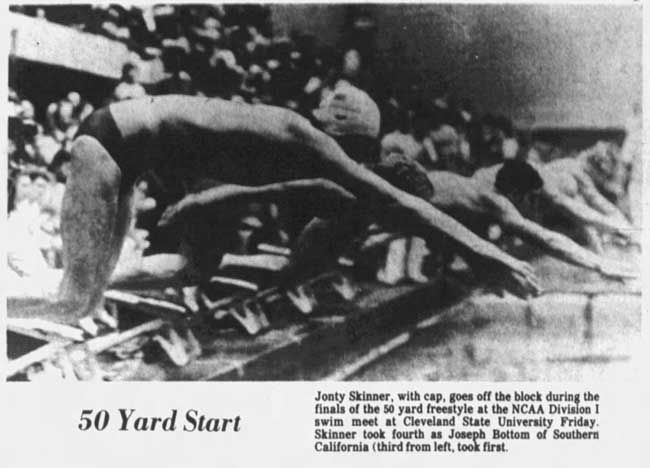
The Post Star Sat Mar 26 1977
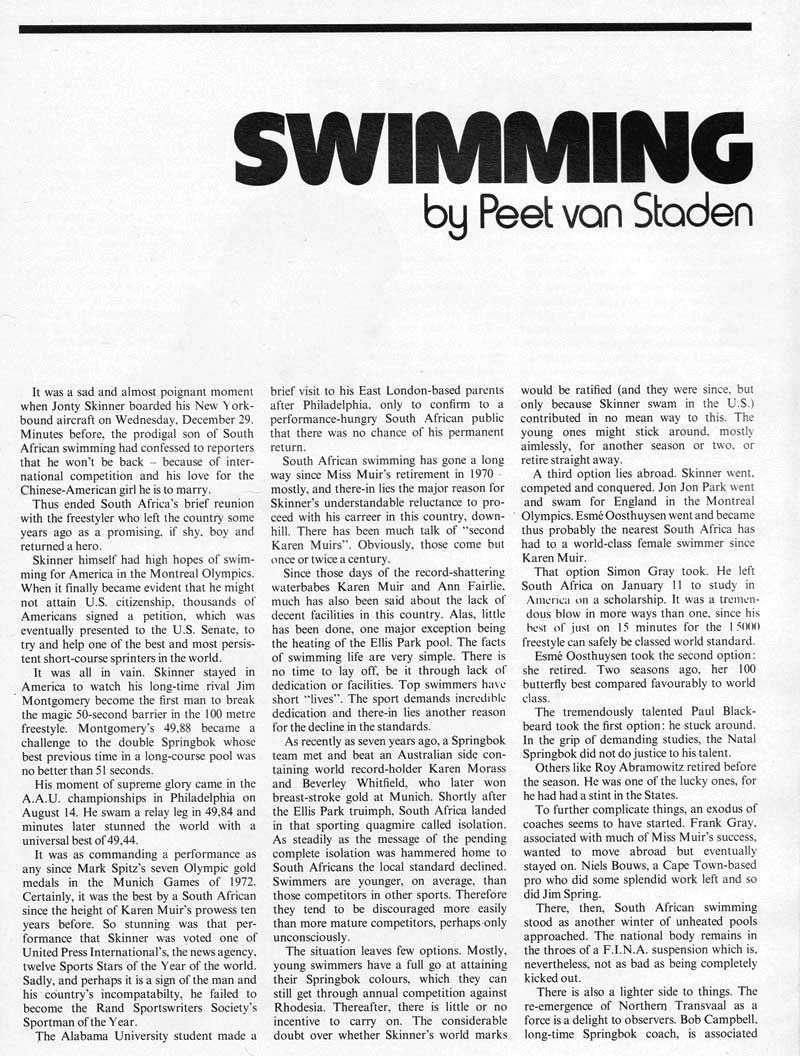
Skinner 19771
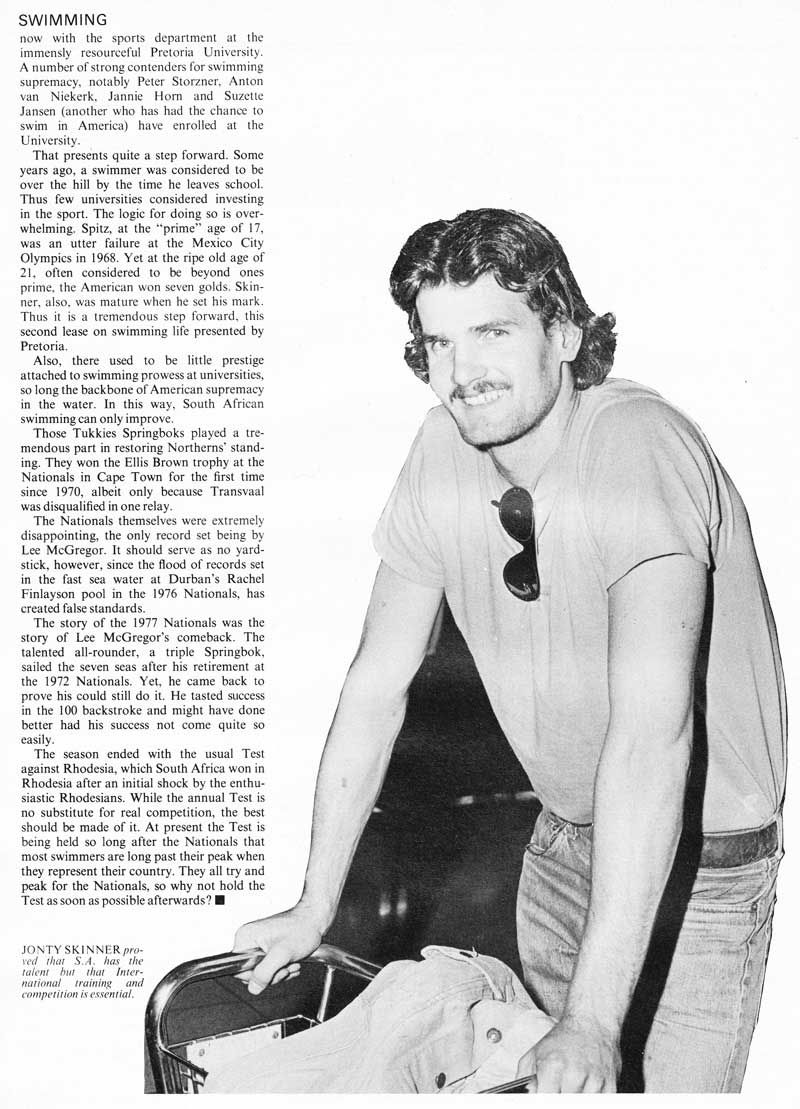
Skinner 19772
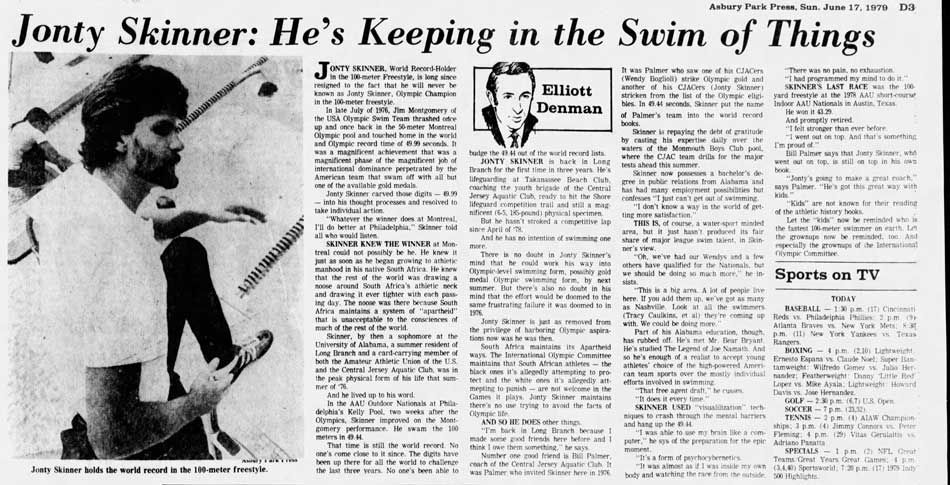
Asbury Park Press Sun Jun 17 1979

Jonty Skinner (RSA)
Honor Swimmer (1985)
The information on this page was written the year of their induction.
FOR THE RECORD: WORLD RECORD: 1976 (100m freestyle); AAU NATIONALS (4): 1976, 1977, 1978 (100yd, 100m freestyle; 1 relay); NCAA CHAMPIONSHIPS: 1975 (100yd freestyle); U.S. OPEN RECORDS: 3 (100yd freestyle); SOUTH AFRICAN CHAMPION: 1973, 1974 (100m freestyle); Awarded South African “National Colours” in Swimming and Life Saving.
John Alexander Skinner, better known as Jonty, was born in South Africa, educated at Alabama and now coaches the San Jose Aquatic Club in California. He weighed 185 pounds, stood 6’5″ and was the fastest sprinter in the world, but it was 1976, and South Africa was non-grata in the Olympic Games. Jonty watched his friends go one, two, three in the Montreal Olympics on television.
Jonty’s big chance came on “The Day,” August 14, 1976 at Philadelphia’s John B. Kelly Pool. It was the U.S. Nationals, held as an anti-climax. It was hard to get oneself up for a race after the Olympics, as many Americans found four years later trying to beat the times they could have swum if not for the Moscow Olympic boycott. Jonty Skinner knew this was the only chance he’d have to prove he was the world’s best sprinter, even if no one was watching.
Skinner was strictly a hundred sprinter. In addition to his World Record, he won the U.S. Nationals three times, the N.C.A.A.’s once and set a U.S. Open Record and three American Records. He was voted Alabama’s most valuable swimmer three straight years and was both Alabama and South Africa Athlete of the Year.
https://ishof.org/honoree/honoree-jonty-skinner/
Happy Birthday Jonty Skinner!!
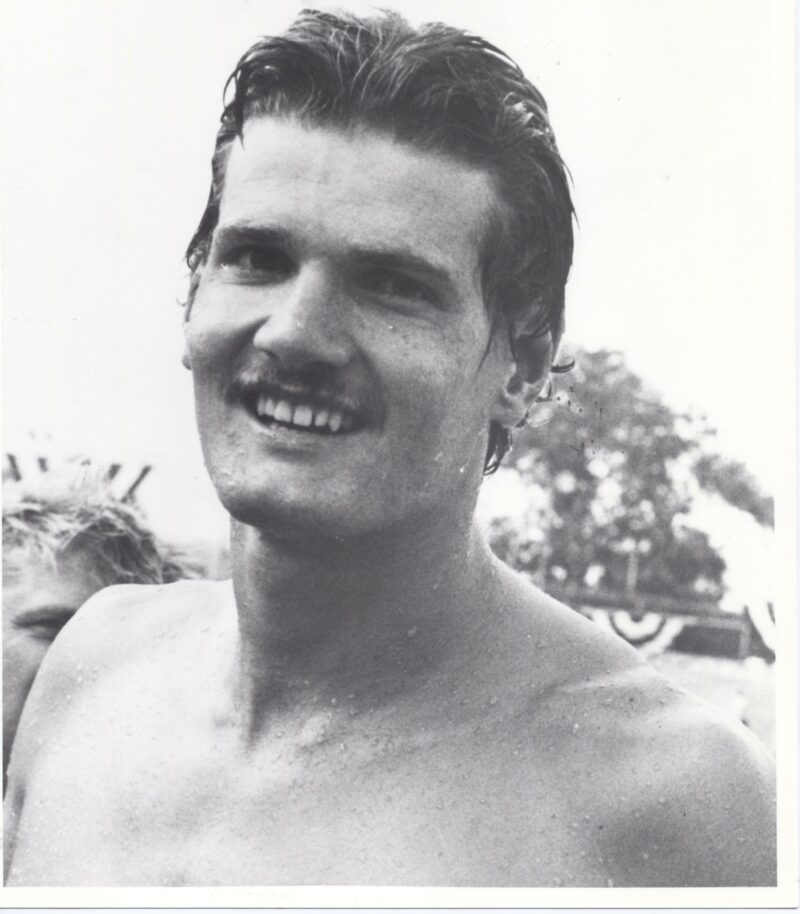
https://ishof.org/happy-birthday-jonty-skinner/
By Rob Marvin
Jonty Skinner (RSA)
Honor Swimmer (1985)
FOR THE RECORD: WORLD RECORD: 1976 (100m freestyle); AAU NATIONALS (4): 1976, 1977, 1978 (100yd, 100m freestyle; 1 relay); NCAA CHAMPIONSHIPS: 1975 (100yd freestyle); U.S. OPEN RECORDS: 3 (100yd freestyle); SOUTH AFRICAN CHAMPION: 1973, 1974 (100m freestyle); Awarded South African “National Colours” in Swimming and Life Saving.
John Alexander Skinner, better known as Jonty, was born in South Africa, educated at Alabama and now coaches the San Jose Aquatic Club in California. He weighed 185 pounds, stood 6’5″ and was the fastest sprinter in the world, but it was 1976, and South Africa was non-grata in the Olympic Games. Jonty watched his friends go one, two, three in the Montreal Olympics on television.
Jonty’s big chance came on “The Day,” August 14, 1976 at Philadelphia’s John B. Kelly Pool. It was the U.S. Nationals, held as an anti-climax. It was hard to get oneself up for a race after the Olympics, as many Americans found four years later trying to beat the times they could have swum if not for the Moscow Olympic boycott. Jonty Skinner knew this was the only chance he’d have to prove he was the world’s best sprinter, even if no one was watching.
Skinner was strictly a hundred sprinter. In addition to his World Record, he won the U.S. Nationals three times, the N.C.A.A.’s once and set a U.S. Open Record and three American Records. He was voted Alabama’s most valuable swimmer three straight years and was both Alabama and South Africa Athlete of the Year.
Barred from the 1976 Olympics, These Swimmers Still Beat Olympic Records
The Story of a Swim Meet in Philadelphia the Week After the Games
Mikael RosénPhiladelphia, August 14, 1976. The stands were packed at Kelly’s pool in Philadelphia. It was 4:30 in the afternoon and the air was hot. It was 91°F (33°C) and the air was trembling.
Behind the starting block for the 100m freestyle race was a tall, slim young man with straight posture, a pronounced chin, and a dark mustache. Someone familiar with British comedy would probably detect a certain resemblance to John Cleese. The blue letters “CJAC” on his orange shirt indicated that he competed for the Central Jersey Aquatic Club. The John Cleese look-alike was in great shape. He spun his arms and looked down the 50-meter pool. The only thing on his mind was the 100m race ahead of him. He’d swum this race before—at least once a day for the past six months.
A downside of the meet was the quality of the pool, far from the standards of the recent Olympic pool of Montreal. The pool in Philadelphia had no wash-through gutter and was only 3 feet (0.9 m) deep in the shallow end. It was very wavy and had just enough room to perform a flip turn without head injury. The Philadelphia Department of Recreation later filled up Kelly’s and replaced it with a lawn bowling court.
That week in August was one long, massive celebration of the American Olympic team, which had won every single medal except one at the men’s events at the Montreal Olympics a few weeks before. Olympic gold medalists such as John Naber, Peter Rocca, John Hencken, and Shirley Babashoff earned a lot of applause, along with the women’s team, which had beaten the fiercely powerful East German team in the 4 x 100m freestyle relay final.
At the races that day, however, there were two other swimmers who brought the sport back to the future: Jonty Skinner and Jesus Vassallo. Jonty Skinner was the name of the John Cleese clone. He stood 6’6” (198 cm) tall and swam for the University of Alabama, where he’d won the NCAA championship in the 100m freestyle a year prior. At that time, the men’s college championships (NCAA) was the fastest swimming competition in the world.
However, Jonty Skinner, a South African, had not been permitted to participate in Montreal. Since the South African Minister of Interior, Jan de Klerk, had proclaimed that its Olympic team would only consist of white athletes, South Africa had not been welcome to participate in the Olympics.
With Skinner absent, Jim Montgomery, who trained in the old home pool of Mark Spitz in Indiana, had won the 100m freestyle in great style. He became the first swimmer to complete a 100-meter race with an average speed of over two meters per second. With this speed, he was able to butcher Mark Spitz’s Olympic record (51.22), and his 49.99 was a whole 0.82 second better than Jack Babashoff, who came in second—and coincidentally used to train with Skinner in Alabama.
Skinner was thrilled to be standing there at Kelly’s pool in the summer heat. He’d been training throughout the whole summer and was in the best shape of his life. As he wasn’t allowed to compete in international championships, he’d never before focused on swimming fast in a 50-meter pool. When asked about his swimming, he’d replied, “Whatever the winning time in Montreal, I will swim faster in Philadelphia.” Skinner was a pioneer in the use of mental visualization. Time and time again, he’d gone through the race in his mind—what it would feel like, what he should focus on, how he would be able to fight the shocking muscle rebellion that breaks out in a swimmer’s body in the second half of a 100m race.
When asked about his swimming, he’d replied, “Whatever the winning time in Montreal, I will swim faster in Philadelphia.”
Jonty Skinner’s leg kick had never been anything to write home about. Other 100m swimmers typically have a constantly pounding leg kick. Skinner’s left foot kicked down once his right hand entered the water, and his right foot went down once his left hand did the same. In between, he let his feet casually rotate around each other—a style he’d developed in his young teens when training under his father, Doug, back home in Cape Town. Other swimmers who’ve used the same type of kick include Anders Holmertz and today’s long-distance champions, Gregorio Paltrinieri and Katie Ledecky. These days, however, practically no one uses Skinner’s technique when swimming the 100m freestyle.
The drawback of this two-stroke leg kick is that it doesn’t provide all that much forward momentum. Nor is it particularly good at lifting the body, especially if the body is more muscular. Jim Montgomery’s 195 pounds were distributed over his 6’3” frame. Jonty Skinner’s slim 6’6” body weighed no more than 185 pounds and was therefore better suited to the two-stroke leg kick. A benefit of using this leg kick is that it saves a lot of energy as long as your feet and legs don’t stick out too much. It may also help your balance, which is why it’s beneficial if you tend to go wide when returning your arms to the water.
Skinner’s technique and mental preparation turned out to be more than sufficient for this race of the year—perhaps even the decade. He crushed the Americans who’d made their way to Philadelphia. Montgomery, the Olympic hero, wasn’t there, but Skinner beat his world record (49.99) with a time of 49.44. This was also the first African world record in swimming and it stood until 1981.
Skinner’s fierce dream race broke the norm of the dominance of the American men’s team in the 1970s. The United States had won 12 out of 13 events at the 1976 Olympics, losing the 200m breaststroke to John Hencken from the United Kingdom. At that time, participating nations were allowed to field three swimmers per event. That meant that there were 33 individual medals up for grabs. The Americans took 25 of these.
https://lithub.com/barred-from-the-1976-olympics-these-swimmers-still-beat-olympic-records/
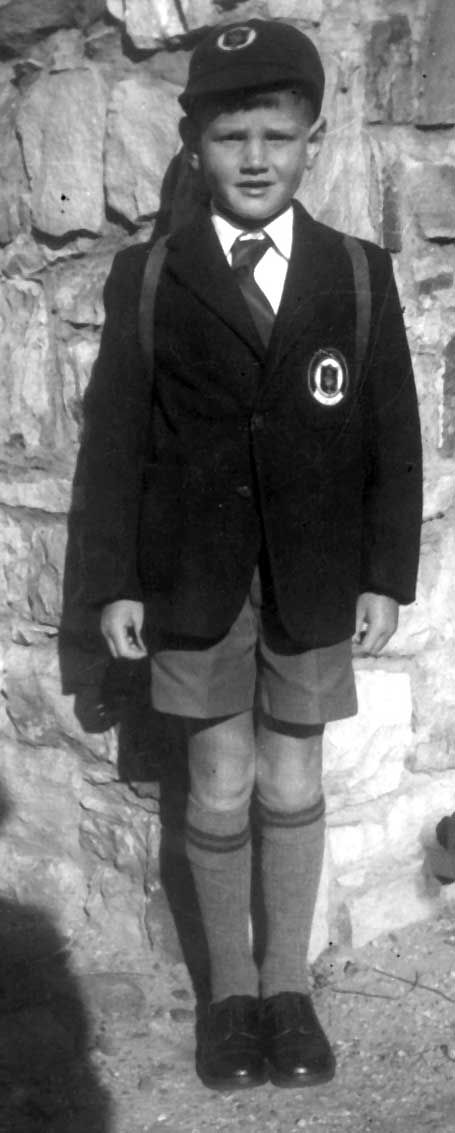
Jonty P Ecirca 59 60
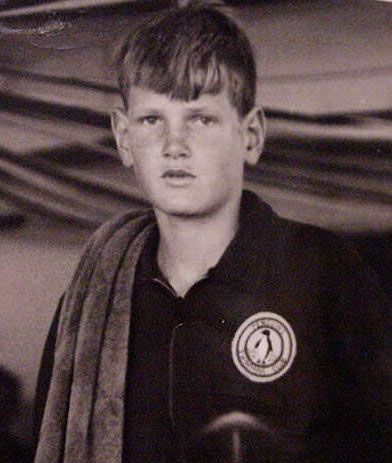
JONTY 12 67
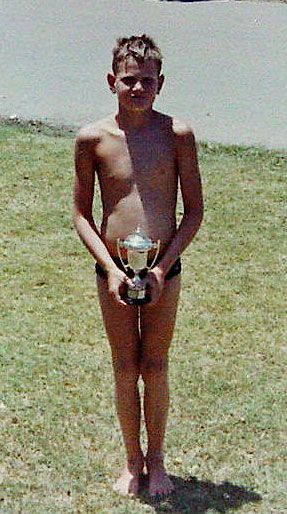
Jonty 1964
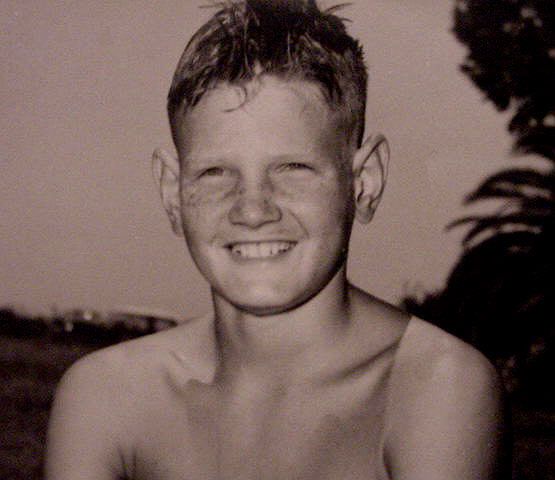
JONTY 02 66
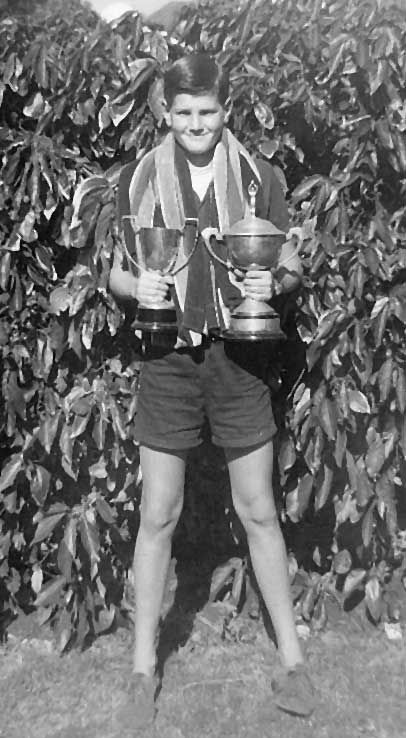
Jonty EL 66 67
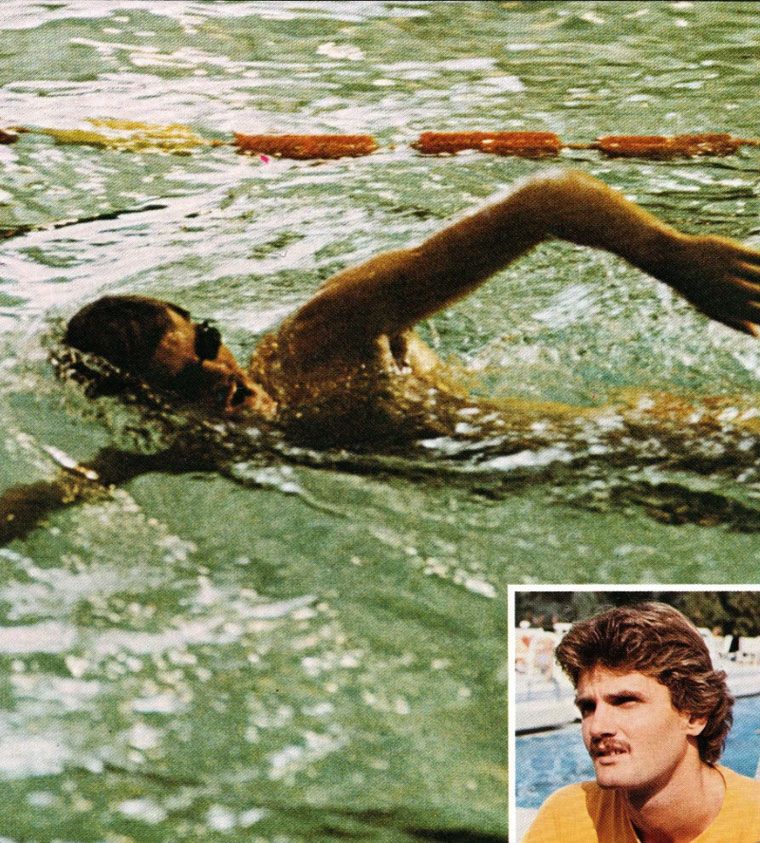
Card 1
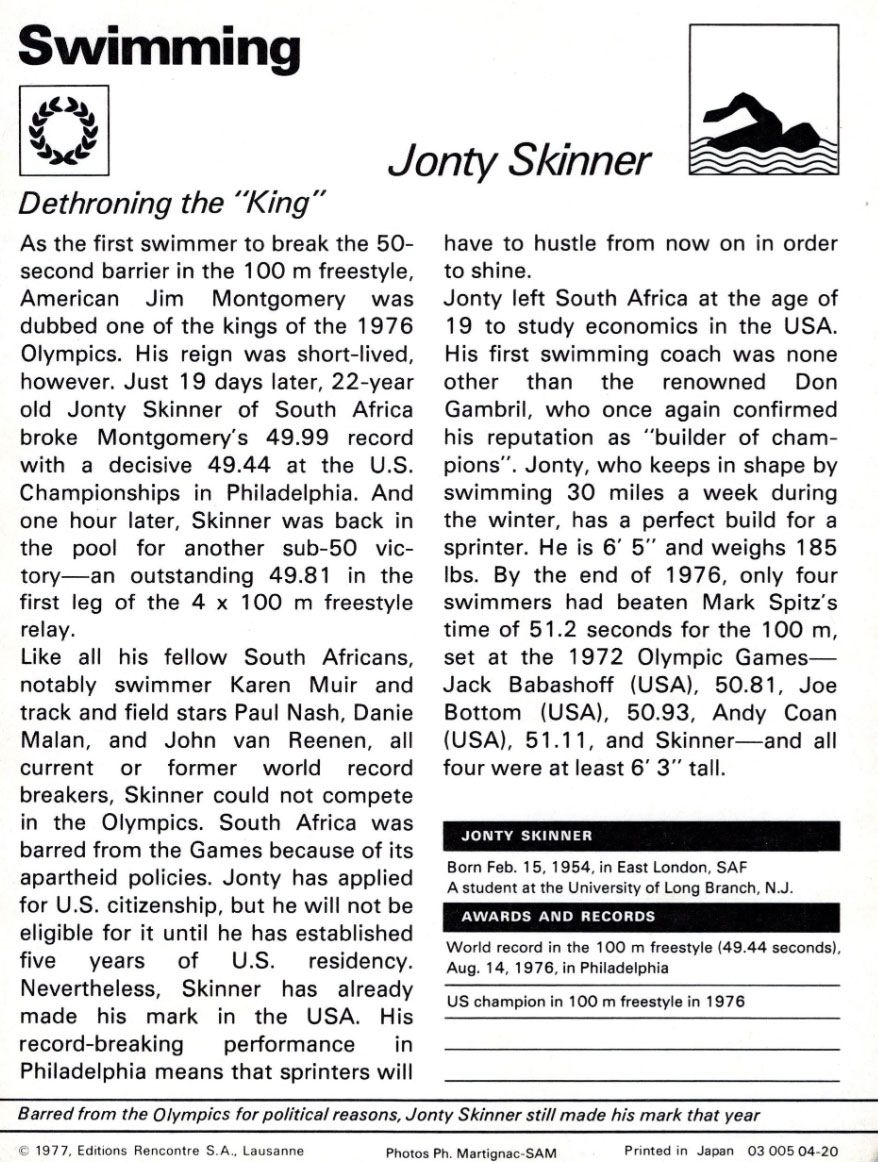
Card 2
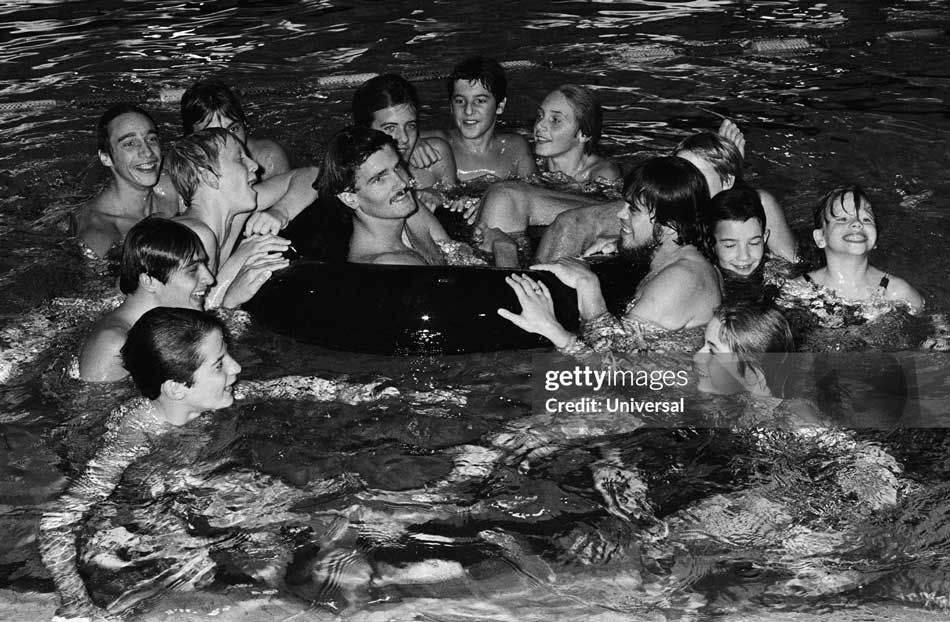
Gettyimages
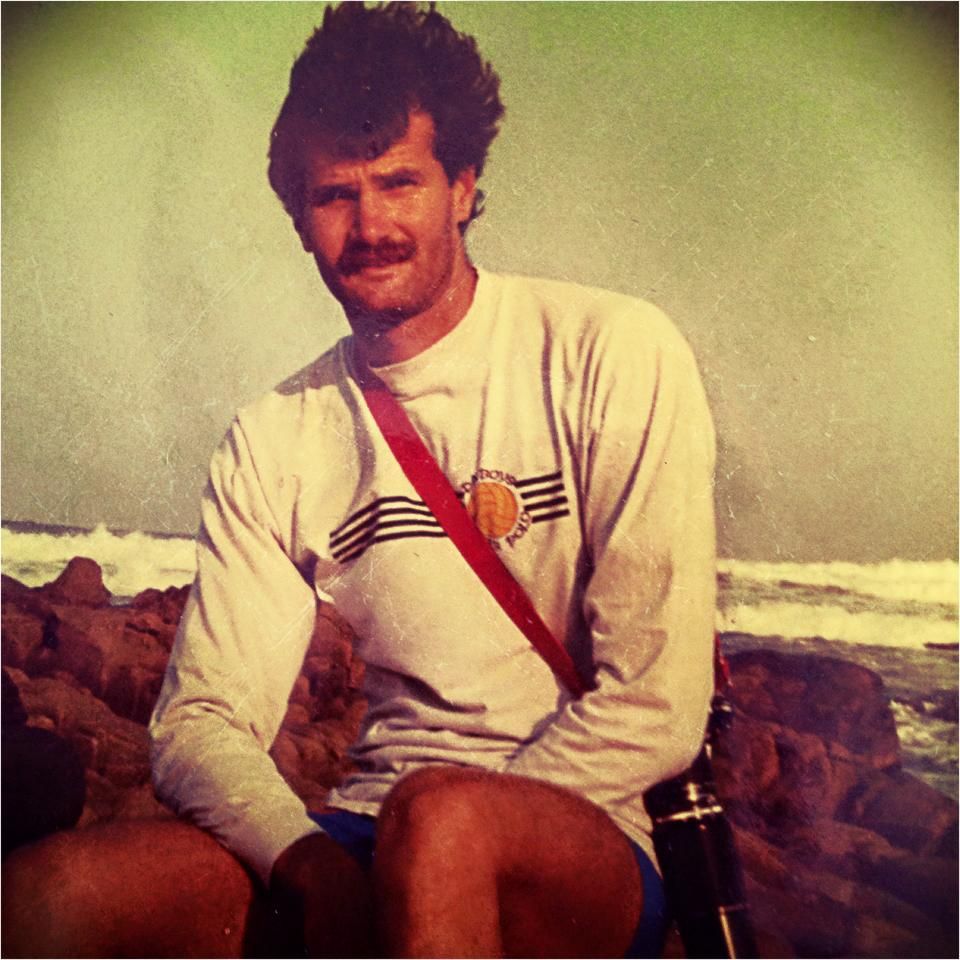
Jonty In EL
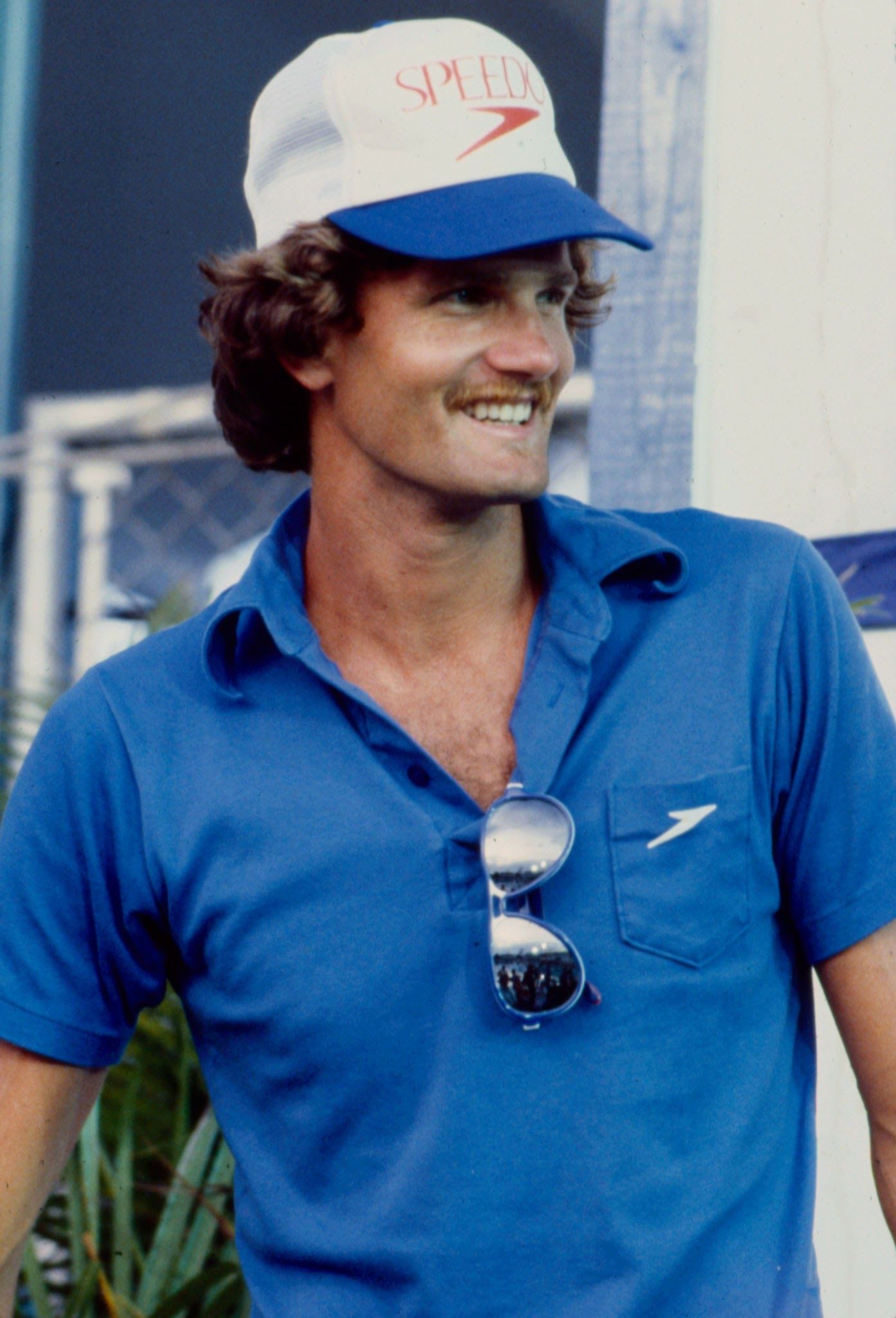
Jonty Speedo
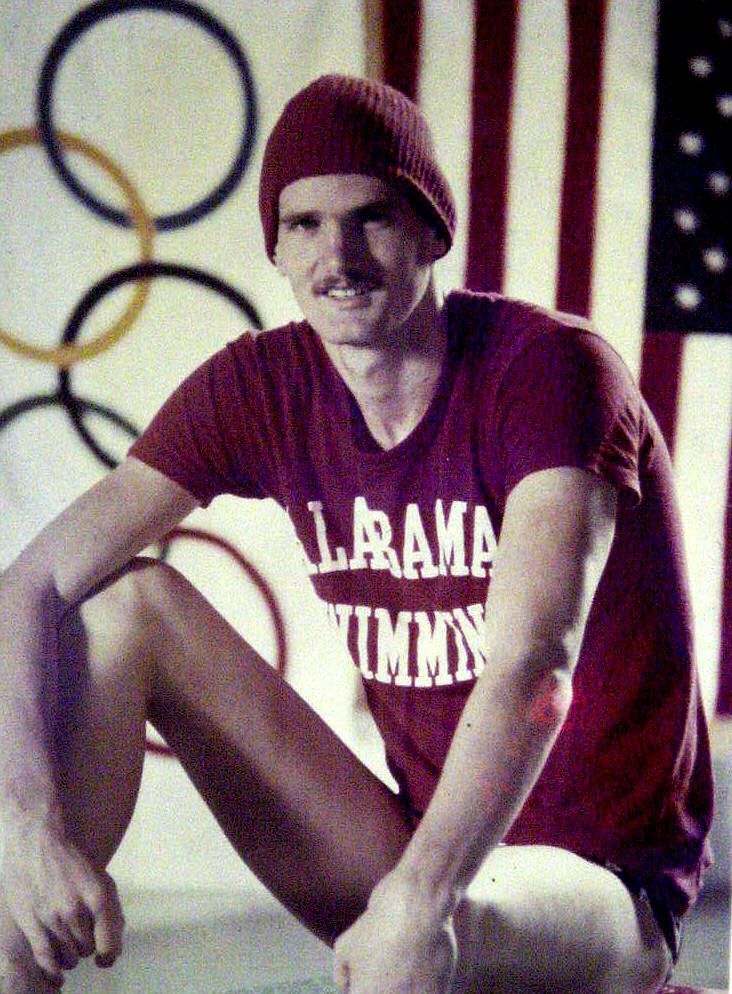
Jonty 03 76
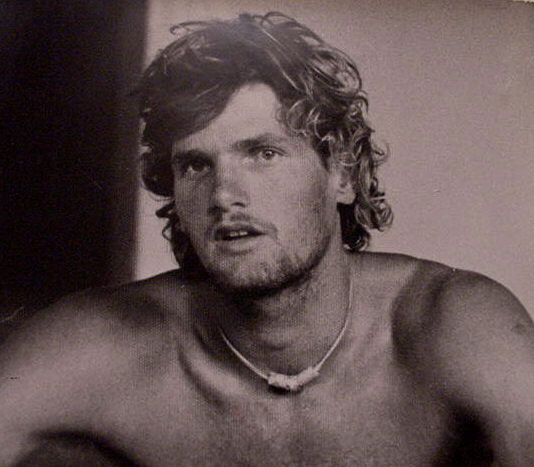
JONTY 10 76
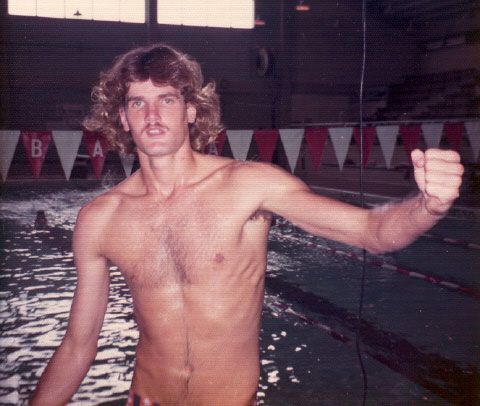
Jonty 1975 1
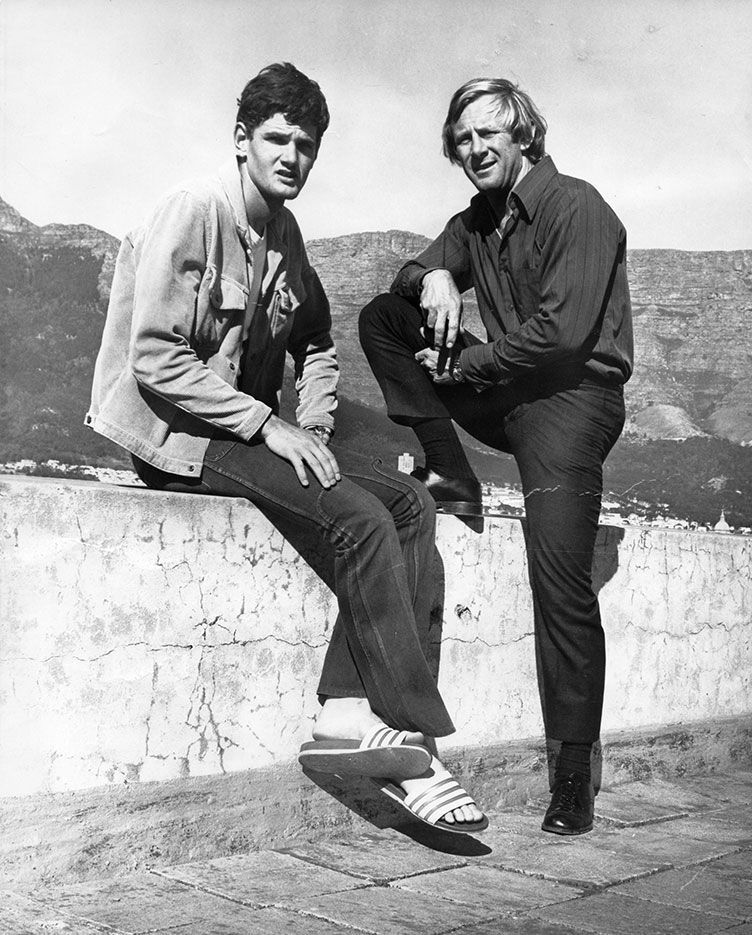
Jonty Skinner Niels Bouws Cape Town 1973
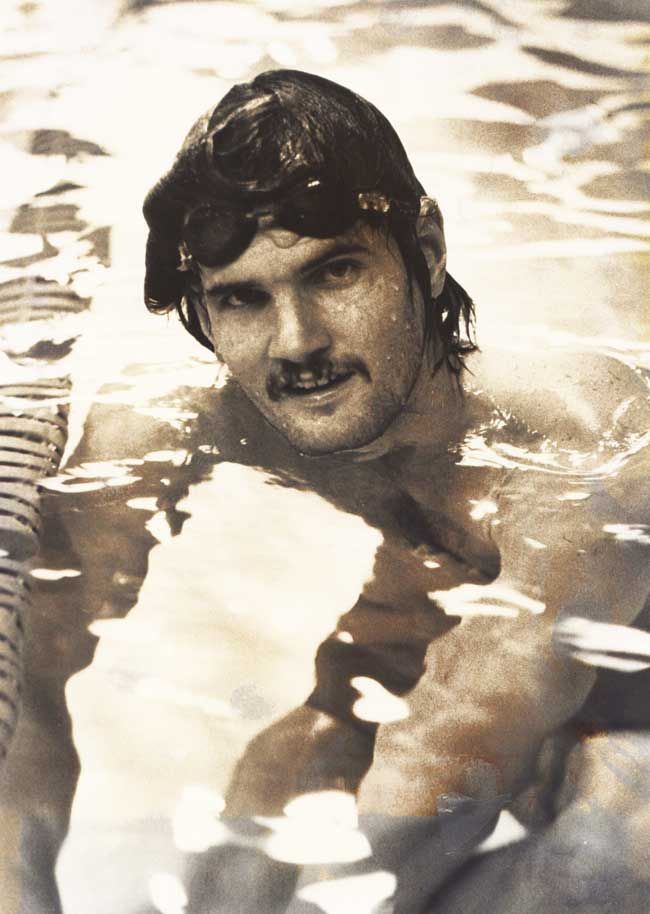
Skinner Jonty 003 Scaled
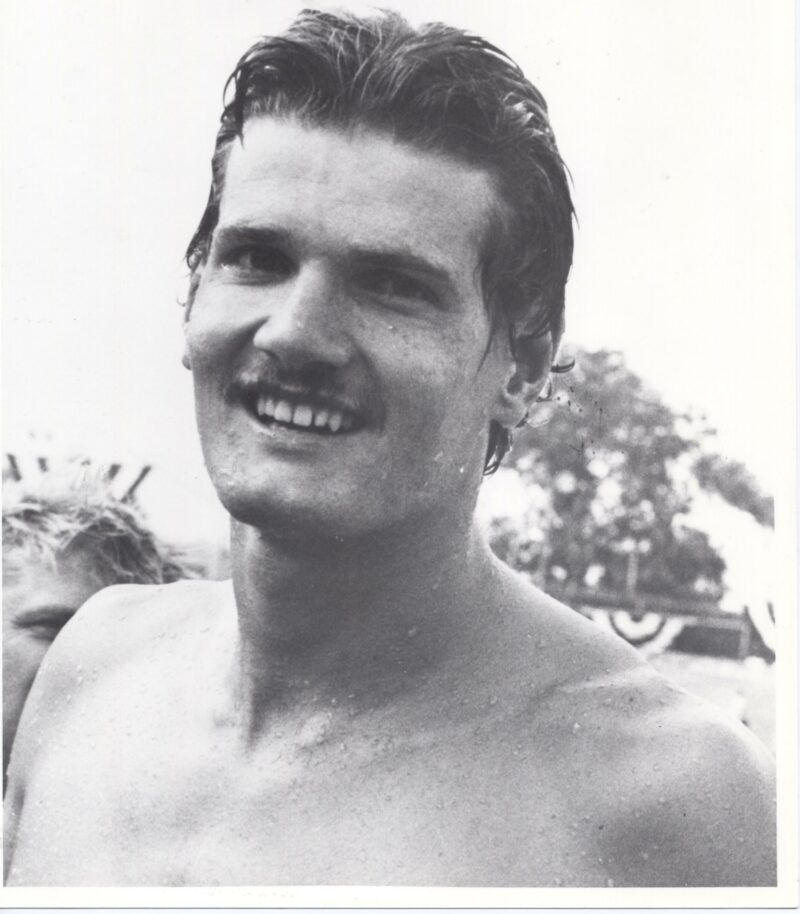
Skinner Jonty 007 800 X 914
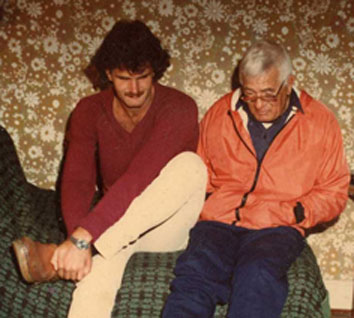
My son Jonty Skinner
By Doug Skinner
Lean, loose-limbed, 1,95m tall Jonty Skinner flew home from the USA in early December. A gentle giant with a slow Southern drawl and complete indifference to the swimming fame that surrounds him.
A slow-moving figure in faded denims and a tatty T-shirts at the pool belies the tremendous athletic ability that galvanizes into action when Jonty is in the water.
His crawl arm stroke has very little dependence on the legs and comprises a 90% power mass ratio arm effort.
He reaches out with the full extension of the arm and shoulder at 30-degree angle. He digs the hand down to push up the elbow to engage the shoulder. This forms the lever and he almost lifts himself over the water so the exit of the hand occurs at the same place it enters.
Jonty broke the world record in most unfavourable conditions at 4:30pm with the air temperature at 90 degrees centigrade so I guess this has to make him the greatest.
His latest academic results are 2 A’s and 4 B’s + 1 C which was pretty good. He is at present the Captain of the Alabama University swim team and his immediate object is to recapture the 100 yards indoor title and improve on his 100 yards record of 43,92.
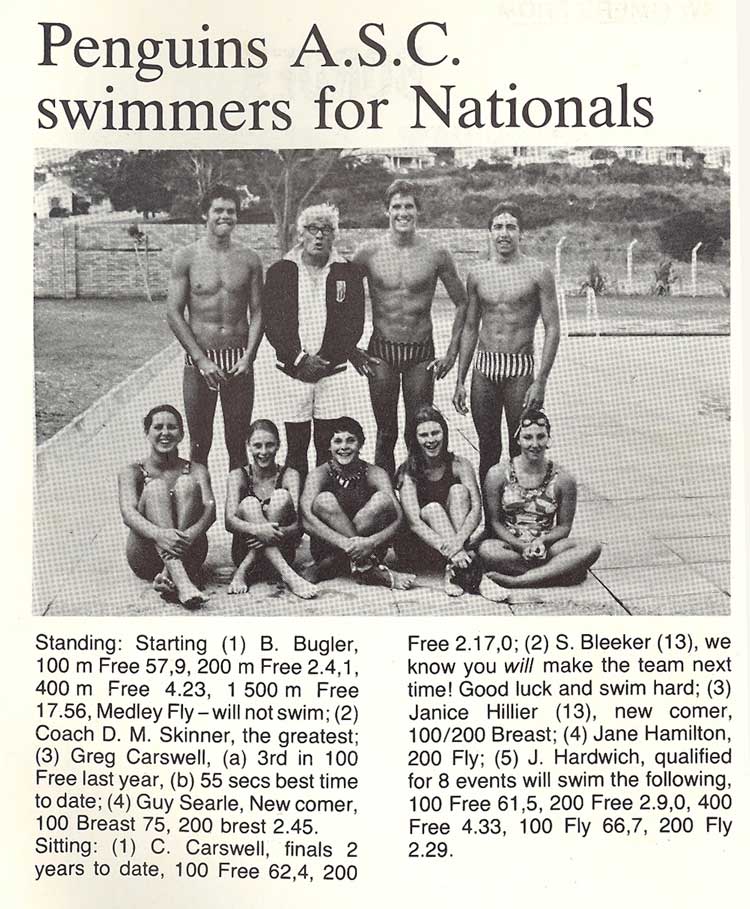
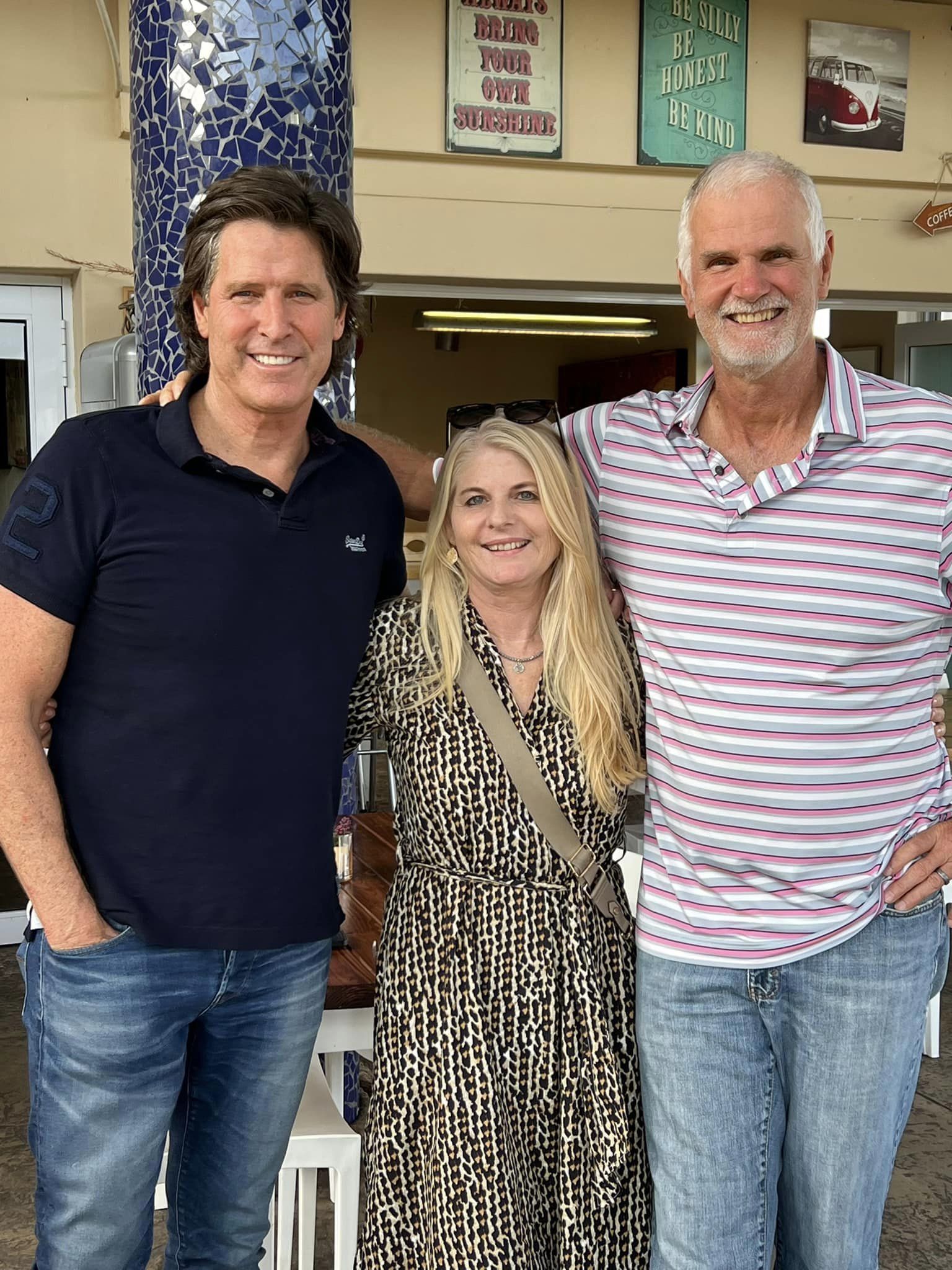
2022 - Jonty Skinner with sister Leigh, and Greg Carswell, who won the 100m freestyle at the 1977 SA Championships in Cape Town. Both old Selborne College pupils
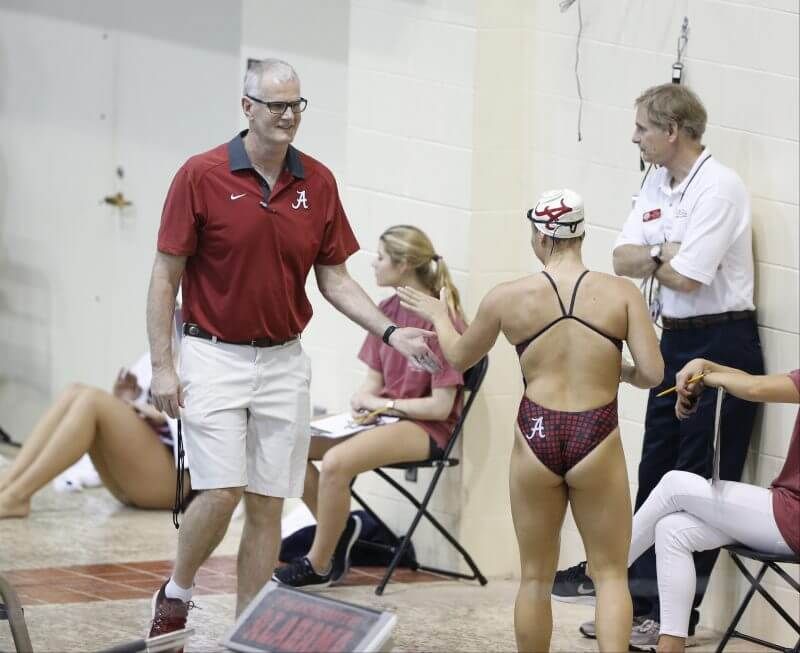
Jonty is a former world record holder and NCAA champion who has been coaching for over 30 years. Throughout his world-renowned coaching career he has been very technical and detail-oriented. The past 10 to 15 years he has been studying the brain and has been reading up on research and experimenting with new techniques with elite level athletes.
